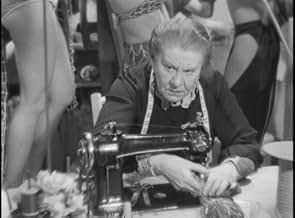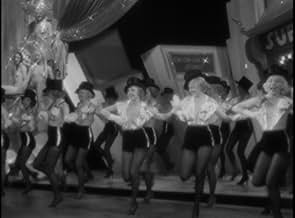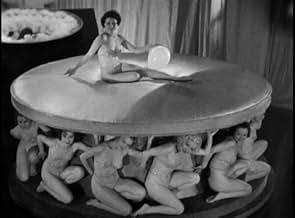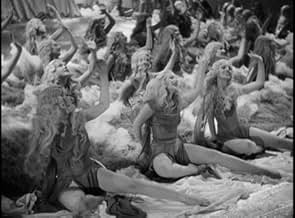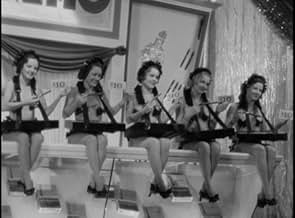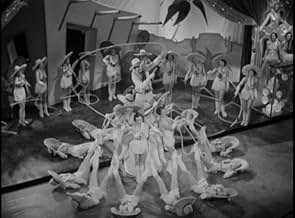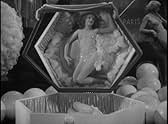Agrega una trama en tu idiomaA homicide detective with an eye for the ladies, investigating a murder in Earl Carroll's Vanities, allows the music revue to continue during the investigation.A homicide detective with an eye for the ladies, investigating a murder in Earl Carroll's Vanities, allows the music revue to continue during the investigation.A homicide detective with an eye for the ladies, investigating a murder in Earl Carroll's Vanities, allows the music revue to continue during the investigation.
- Dirección
- Guionistas
- Elenco
- Premios
- 1 premio ganado en total
Charles Middleton
- Homer Boothby
- (as Charles B. Middleton)
Ernestine Anderson
- Earl Carroll Girl
- (sin créditos)
Lona Andre
- Lona - Earl Carroll Girl
- (sin créditos)
William Arnold
- Treasurer
- (sin créditos)
Lucille Ball
- Earl Carroll Girl
- (sin créditos)
Lucille Battle
- Black Dancer in Ebony Rhapsody number
- (sin créditos)
Opiniones destacadas
Released just before the Production Code crackdown in July, 1934, Mitch Leisen's all-star Paramount musical is both leeringly suggestive -some even claim misogynistic- and a heck of a lot of fun. Two murders occur on the opening night of "Earl Carroll's Vanities" (one on-stage), but that doesn't stop the manager (Jack Oakie) from putting on a show as a lascivious police detective (Victor McLaglen) investigates. Everyone is hiding something and Gypsy Rose Lee must have seen this backstage murder mystery before she penned "The G-String Murders" as the denouement is similar, albeit more satisfying here. Gertrude Michael, as a vicious diva, stops the show (in more ways than one) with her exotic "Sweet Marijuana" number and Duke Ellington finishes with the truncated "Rape Of The Rhapsody". The hit song, "Cocktails For Two", also came from this bizarre and bawdy camp classic. Here's Louella O. Parsons in the "Los Angeles Examiner" on May 17, 1934:
Earl Carroll's hand-picked beauties' pirouette about on the Grauman United Artists screen in a fig leaf and not much else. But September Morn herself never had a better figure than these charmers, who are made up to please the eye, especially the eye of the tired businessman. But don't for a moment think Mr. Carroll's girls, au naturelle, are the only attraction. Believe it or not, MURDER AT THE VANITIES is a musical comedy thriller, if you know what I mean -a murder mystery incorporated in a musical show. It all happens on the opening night at the time the play is in progress and a search is on for a murderer. Just by way of suspense, a cop threatens to stop the show every few minutes. Victor McLaglen is something new in cops. All the time he is trying to track down the murderer, he keeps his eye fastened on the chorus beauties. The murder mystery is good with the exception of the denouement, which is pretty flat. Probably faulty direction. Dorothy Stickney, who plays the maid, is about as melodramatic as the heroine in a ten, twenty, and thirty show. For no good reason, she rates a never-ending closeup in the big dramatic scene. The girl ensembles are good, and it's a positive relief to get away from the inevitable overhead shots. The costumes are beautiful; in fact, this is a musical that Paramount can feel is really to their credit. As for Carl Brisson -well, he would be an addition to any show. Good-looking with a delightful singing voice and an easy, assured manner, he is all his press agents claim for him. I also like Kitty Carlisle, who plays the leading lady in the show. Gertrude Michael, as the deep-eyed villainess, gives an interesting if rather fictional portrayal. Jack Oakie, as the stage manager, is the same old wisecracking Jack, but we wouldn't change him. Jessie Ralph is excellent as the seamstress. Others in the cast are Charles Middleton, Gail Patrick, Donald Meek, Barbara Fritchie, Toby Wing and Lona Andre. The screen play is by Carey Wilson and Rufus King, and the direction by Mitchell Leisen. The music is by Arthur Johnstone and the lyrics by Sam Coslow. In addition to MURDER AT THE VANITIES, there is a Mickey Mouse cartoon, a Paramount Newsreel, and a two-reeler, THE WRONG DIRECTION.
I disagree with Lolly on the denouement, it's satisfying if over-the-top. Why would she blame the director? Was she displeased with the story's ending -or the way it was staged? And what's a "ten, twenty, or thirty show"? Note the swipe taken at Busby Berkeley and his "overhead shots". As hard as it may be to believe today, the public was tiring of Buzz' schtick by May, 1934. Mitch Leisen said, "if you are showing a stage show that's supposed to be in a theater, you should stay within the bounds of the proscenium arch, and not do a Buzz Berkeley routine with a stage set that's acres big."
Q: Don't you think Berkeley's spectacular effects justified taking this liberty? ML: Apparently they did because they're reviving all of his pictures and none of mine, but personally I don't like it.
Earl Carroll's hand-picked beauties' pirouette about on the Grauman United Artists screen in a fig leaf and not much else. But September Morn herself never had a better figure than these charmers, who are made up to please the eye, especially the eye of the tired businessman. But don't for a moment think Mr. Carroll's girls, au naturelle, are the only attraction. Believe it or not, MURDER AT THE VANITIES is a musical comedy thriller, if you know what I mean -a murder mystery incorporated in a musical show. It all happens on the opening night at the time the play is in progress and a search is on for a murderer. Just by way of suspense, a cop threatens to stop the show every few minutes. Victor McLaglen is something new in cops. All the time he is trying to track down the murderer, he keeps his eye fastened on the chorus beauties. The murder mystery is good with the exception of the denouement, which is pretty flat. Probably faulty direction. Dorothy Stickney, who plays the maid, is about as melodramatic as the heroine in a ten, twenty, and thirty show. For no good reason, she rates a never-ending closeup in the big dramatic scene. The girl ensembles are good, and it's a positive relief to get away from the inevitable overhead shots. The costumes are beautiful; in fact, this is a musical that Paramount can feel is really to their credit. As for Carl Brisson -well, he would be an addition to any show. Good-looking with a delightful singing voice and an easy, assured manner, he is all his press agents claim for him. I also like Kitty Carlisle, who plays the leading lady in the show. Gertrude Michael, as the deep-eyed villainess, gives an interesting if rather fictional portrayal. Jack Oakie, as the stage manager, is the same old wisecracking Jack, but we wouldn't change him. Jessie Ralph is excellent as the seamstress. Others in the cast are Charles Middleton, Gail Patrick, Donald Meek, Barbara Fritchie, Toby Wing and Lona Andre. The screen play is by Carey Wilson and Rufus King, and the direction by Mitchell Leisen. The music is by Arthur Johnstone and the lyrics by Sam Coslow. In addition to MURDER AT THE VANITIES, there is a Mickey Mouse cartoon, a Paramount Newsreel, and a two-reeler, THE WRONG DIRECTION.
I disagree with Lolly on the denouement, it's satisfying if over-the-top. Why would she blame the director? Was she displeased with the story's ending -or the way it was staged? And what's a "ten, twenty, or thirty show"? Note the swipe taken at Busby Berkeley and his "overhead shots". As hard as it may be to believe today, the public was tiring of Buzz' schtick by May, 1934. Mitch Leisen said, "if you are showing a stage show that's supposed to be in a theater, you should stay within the bounds of the proscenium arch, and not do a Buzz Berkeley routine with a stage set that's acres big."
Q: Don't you think Berkeley's spectacular effects justified taking this liberty? ML: Apparently they did because they're reviving all of his pictures and none of mine, but personally I don't like it.
Detective Victor McLaglen has to investigate a backstage murder and not mess up the debut of pal Jack Oakie's musical revue. You won't care about the rather hum-drum murder, the musical numbers will floor you. During a performance of "Sweet Marijuana", (this virtual lullaby to reefer has topless back-up dancers!) blood from the murder victim in the rafters drips down on the dancing girls! Toby Wing is fun and cute as the flirty chorus girl with a crush on Oakie. Loads fun here!
Thus sumptuous Paramount art deco musical is almost a definitive pre code extravaganza and is on per with WONDERBAR and FASHIONS OF 1934 and TOP HAT as the glittering perfection of code- cusp risqué showgirl and nightclub sophisticated sexiness. Made at Paramount in late 1933 and clearly designed to outshine the WB Busby Berkeley extravaganzas, this one does it with nude showgirls, drug references, weapons, a slinky killer, murder in the ceiling and dripping blood, and big stage show numbers all crammed over the orchestra pit on the opening night of a big Broadway show. I was reminded of almost every Busby Berkeley film but clearly on a lower budget with the difference being made up by having spectacular costumes. In color this film would be an enduring musical of its time. In gorgeous B&W it still rates but one can see how colorful the costumes are even in monochrome. One startling song SWEET MARIJUANA manages the unparalleled feat of including nudity drugs murder and blood all on screen during the tune. There is a hilarious and nutty island mermaid number and a fantastic and simple art deco staging of COCKTAILS FOR TWO. This film clearly influenced THE GREAT ZIEGFELD made at MGM in 1936.
Murder mystery with a musical backdrop shows its age but has some interesting numbers in particular Duke Ellington's orchestra's production and the now infamous Marijuana number with discreetly covered but unquestionably topless showgirls. Lost in amongst the hundreds of hopeful showgirls and chorus boys are Lucille Ball, Ann Sheridan and Alan Ladd all still years away from any kind of fame and hard to spot. The acting is okay but this is more of a curio as a good example of some of the things that were common before the code, implied or actual nudity, drug references and occasional swearing that would disappear for almost 3 decades when the Hayes code took full effect within a very short time after this film premiered.
I just viewed MURDER AT THE VANITIES in the newly-released Universal Pre-Code set, and I was amazed at how much I enjoyed the vehicle end to end. Most of the other commentators have covered the story, a murder mystery within a musical, but I wanted to add a few additional notes. Brisson and Carlisle are relatively bland, compared to even most of the minor players, and neither one really seems to have the proper voice for what they're singing (Carlisle being a trained opera singer, Brisson a bit wobbly on some of his high and low notes). The great Victor McLaglen and Jack Oakie play well off each other, with an excellent sense of timing that keeps the ball rolling between musical numbers. Yes, Lucille Ball and Ann Sheridan are Vanities girls, but let's not forget the splendid jazz singer Ernestine Anderson in the "Ebony Rhapsody" number. Gail Patrick makes one of her early appearances, sounding a bit like Eve Arden; Patrick would go on to become the executive producer of the Perry Mason TV series. Then there's Jessie Ralph as the wardrobe mistress--you'll spot her also in David COPPERFIELD (as Aunt Peggoty) and THE BANK DICK. The music is very good--Brisson introducing the standard "Cocktails for Two" in two different scenes; "Sweet Marihuana" with barely clad peyote button girls in the background (blood dripping on one chorine's white skin was wonderfully chilling); the "Ebony Rhapsody," with Duke Ellington's Orchestra and a bevy of beautiful dancers, both black and white, mixing it up. And I believe this is one of the only early musicals to feature such a mix--and the costumes leave nothing to the imagination.
¿Sabías que…?
- TriviaMany of the Earl Carroll Girls featured in the film were authentic cast members from Carroll's stage show, which ran from September 12th to November, 1933, at the New Amsterdam Theatre, and at the Majestic Theatre from November 6th, 1933 to March 10th, 1934. These cast members were brought out to Hollywood from New York especially for this film, and many stayed to pursue film careers.
- ErroresWhen the body of the woman on the catwalk is turned on her back, you can see the actress' chest rise and fall as she takes a breath.
- Citas
[last lines]
Jack Ellery: Nancy, what shall I do?
Nancy: Oh, Mr. Ellery!
Jack Ellery: C'mon, let's do it.
- ConexionesEdited into The Big Broadcast of 1937 (1936)
- Bandas sonorasEbony Rhapsody
(uncredited)
by Arthur Johnston and Sam Coslow
Sung by Carl Brisson, Kitty Carlisle and Gertrude Michael
Selecciones populares
Inicia sesión para calificar y agrega a la lista de videos para obtener recomendaciones personalizadas
- How long is Murder at the Vanities?Con tecnología de Alexa
Detalles
- Fecha de lanzamiento
- País de origen
- Idioma
- También se conoce como
- Tajne Varijetea
- Locaciones de filmación
- Productora
- Ver más créditos de la compañía en IMDbPro
- Tiempo de ejecución1 hora 29 minutos
- Color
- Relación de aspecto
- 1.37 : 1
Contribuir a esta página
Sugiere una edición o agrega el contenido que falta

Principales brechas de datos
By what name was Murder at the Vanities (1934) officially released in India in English?
Responda

